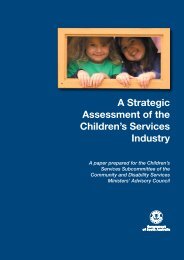Global Study On Child Poverty And Disparities (PDF) - Social Policy ...
Global Study On Child Poverty And Disparities (PDF) - Social Policy ...
Global Study On Child Poverty And Disparities (PDF) - Social Policy ...
Create successful ePaper yourself
Turn your PDF publications into a flip-book with our unique Google optimized e-Paper software.
Malaria is the major public health problem in the<br />
country; other communicable diseases include<br />
tuberculosis, sexually transmitted infections,<br />
acute respiratory tract infections including<br />
pneumonia; diarrhoeal diseases, viral hepatitis,<br />
typhoid fever and measles. The Ministry of Health<br />
has run awareness campaigns for the past 20<br />
years to try to eradicate these communicable<br />
diseases.<br />
In 2008, the rapid diagnostic test for malaria was<br />
introduced in all health facilities. Annual parasite<br />
incidence decreased from a baseline of 73.9<br />
positive cases per 1,000 inhabitants to 23.3 per<br />
1,000 in 2007, 15.6 per 1,000 in 2008, and 13.3<br />
per 1,000 in 2009. This decline has opened up<br />
the prospect of further reduction and eventual<br />
elimination of malaria.<br />
The Ministry of Health has introduced longlasting,<br />
insecticide-treated nets, using funding<br />
from the <strong>Global</strong> Fund to Fight HIV/AIDS,<br />
Tuberculosis and Malaria, to combat malaria. The<br />
use of bed nets now seems to be widespread,<br />
with 56 per cent of children sleeping under nets<br />
in 2007. In 2009, long-lasting insecticide-treated<br />
mosquito net (LLIN) distribution increased to 85<br />
per cent. Nevertheless, concentrated efforts are<br />
still needed to achieve the elimination target.<br />
Tuberculosis is a national concern in both urban<br />
and rural settings. From 2000 to 2007, the<br />
average annual prevalence rate was six cases<br />
per 10,000 inhabitants, which corresponds to 120<br />
tuberculosis cases a year. The Ministry of Health<br />
has implemented the directly observed treatment,<br />
short-course (DOTS) strategy. The case detection<br />
rate was 52 per cent in 2008, and the treatment<br />
success rate was 93 per cent in 2007. The<br />
programme is now concentrating on quality,<br />
consistency and sustainability issues.<br />
Dengue fever, dengue haemorrhagic fever and<br />
filariasis are also significant communicable<br />
diseases, and the Directorate of Public Health<br />
Table 3.2: Under-five and infant mortality rates and their correlates, 2007<br />
has implemented an extensive vector-bornedisease<br />
control programme over the past 20<br />
years. Five rounds of mass drug administration<br />
against filariasis have been completed, and<br />
the programme is now in an evaluation and<br />
surveillance phase.<br />
Sexually transmitted infections have always been<br />
suspected of being highly prevalent, and data<br />
from health facilities support this belief. Acute<br />
respiratory infections and diarrhoeal diseases<br />
also contribute significantly to the morbidity<br />
burden. <strong>Child</strong>ren under two years of age account<br />
for about 50 per cent of all hospital admissions for<br />
acute respiratory infections.<br />
Non-communicable diseases, especially diabetes<br />
and hypertension, have become more prominent<br />
in recent years; in 2006, diabetes was the 8 th<br />
leading cause of illness requiring inpatient care<br />
and hypertension the 10 th leading cause. Lifestyle<br />
changes and growing urbanization appear to be<br />
the main causes of this trend.<br />
<strong>Child</strong> outcomes, disparities and<br />
gender equality<br />
Table 3.2 shows the infant mortality rate (the<br />
probability of children dying before their first<br />
birthday) and the under-five mortality rate (the<br />
probability of dying before the fifth birthday). The<br />
national rates are 25 and 30 deaths, respectively,<br />
per 1,000 live births. There are no significant<br />
differences in these rates by gender. Rural areas<br />
have somewhat higher mortality rates than<br />
urban areas, and the poorest 60 per cent have<br />
higher mortality rates than the richest 40 per<br />
cent. Mother’s education is closely associated<br />
with infant and child mortality rates, with rates for<br />
children of mothers with no education or primary<br />
education two to three times as high as those for<br />
children whose mothers completed secondary<br />
school.<br />
Background characteristics Infant mortality rate Under-five mortality rate<br />
Sex Male 25 29<br />
Female 25 31<br />
Residence Urban 23 27<br />
Rural 26 32<br />
Mother’s education None/primary only 28 34<br />
Secondary or higher 12 14<br />
Wealth index quintiles Poorest 60% 27 33<br />
Richest 40% 22 26<br />
National 25 30<br />
Source: MICS 2007.<br />
57
















